Labour Force
- Home
- Statistics
- Labour Market
- Labour Market Information
- Labour Force
Key Statistics of Labour Force in Malaysia, April 2022
Key Statistics of Labour Force in Malaysia, March 2022 10 May 2022
Principal Statistics of Labour Force, Malaysia, First Quarter (Q1) 2022 27 April 2022
Labour Force Survey Report, Malaysia, 2021 8 April 2022
Key Statistics of Labour Force in Malaysia, February 2022 9 March 2022
Key Statistics of Labour Force in Malaysia, January 2022 8 February 2022
Principal Statistics of Labour Force, Malaysia, Fourth Quarter (Q4) 2021 Show all release archives
Overview


KEY REVIEWS
- Employed persons remained on a positive trend with a month-on-month increase of 0.5 per cent or equivalent to 84.1 thousand persons to record 15.85 million persons in April 2022 (March 2022: 15.77 million persons). Similarly, in terms of seasonally adjusted, the number of employed persons heightened by 0.6 per cent. The employment-to-population ratio which indicates the ability of an economy to create employment augmented by 0.3 percentage points to record 66.7 per cent as compared to 66.4 per cent in March 2022.
- By economic sector, the number of employed persons in Services sector sustained the positive trend particularly in Wholesales & retail trade; Food & beverage services and Human health & social work activities. The number of employed persons in Manufacturing and Construction sectors also continued to increase. The Agriculture sector recorded an increase in the number of employed persons for the first time in April after 22 consecutive months of month-on-month decline. In the meantime, the Mining & quarrying sector continued to record a reduction in employment.
- The employee’s category which made up the largest composition of employed person at 76.3 per cent, improved by 0.3 per cent month-on-month to 12.09 million persons (March 2022: 12.06 million persons). Similarly, the own-account workers continued to increase with an addition of 31.9 thousand (+1.2%) persons to 2.72 million persons in April 2022 (March 2022: 2.69 million persons). The increase was partly due to more business activities in conjunction with the celebration of Ramadan and preparation for Aidilfitri during the month parallel with the reopening of international border which encouraged the tourism sector and tourism-related industries to resume their activities.
- In April 2022, the number of unemployed persons continued to trend down for nine consecutive months, registering a fall of 3.0 per cent or equivalent to 19.9 thousand persons to 649.3 thousand unemployed persons (March 2022: 669.2 thousand persons). Meanwhile, on a seasonally adjusted terms, the number of unemployed persons went down by 4.1 per cent. Hence, the unemployment rate declined to below 4.0 per cent for the first time to record 3.9 per cent (March 2022: 4.1%) after two years of the COVID-19 pandemic in the country. Seasonally adjusted estimates for the April’s unemployment rate indicated a month-on-month decline by 0.2 percentage points to 3.9 per cent.
- In April 2022, the number of labour force recorded a surge of 0.4 per cent (+64.3 thousand persons) month-on-month to 16.50 million persons (March 2022: 16.44 million persons). Accordingly, April’s labour force participation rate (LFPR) strengthened further by 0.2 percentage points to 69.4 per cent (March 2022: 69.2%), indicating more labour participation in the market. In terms of seasonally adjusted estimates, the number of labour force increased by 0.4 per cent while LFPR rose by 0.3 percentage points.
- Following the shift into the phase of transition to endemic in April 2022, the number of persons outside labour force continued to decline with a reduction of 39.5 thousand persons (-0.5%) to record 7.27 million persons (March 2022: 7.31 million persons). The largest composition of outside labour force was housework/ family responsibilities with 42.0 per cent and followed by schooling/ training category (40.6%).
- Moving forward, the increase in employers’ applications for non-citizen employment following the reopening of the country's international borders is anticipated to be able to ease the labour shortages issues especially in the Construction and Agriculture sectors; and subsequently further stimulate the country’s labour market situation. Furthermore, the inflow of international tourist could also contribute to the revival of the tourism industry particularly in the accommodation sub-sector. Besides the negativity of the depreciation of the Malaysian Ringgit against the US Dollar towards the economy, it may initiate a positive impact on the tourism sector in terms of lower cost for tourists and it will make the country as a preferred holiday destination. Tourists spending also may facilitate small businesses to rebound after a two-year period of difficulties due to pandemic. This situation is seen to open up more job opportunities since business activities require more workers to accommodate the growing demand for goods and services. Thus, the labour market is foreseen to be able to sustain its resiliency in the months to come.
LABOUR MARKET CONDITION IN APRIL 2022 WAS FURTHER STRENGTHENED WITH THE CONTINUOUS INCREASE IN EMPLOYMENT, WHILE THE UNEMPLOYMENT REMAINED ON A DECLINING TREND AS ALL ECONOMIC ACTIVITIES STARTED TO BOOM
At the beginning of April 2022, Muslims all over the world including Malaysia celebrated the holy month of Ramadan. Apart from the health and spiritual benefits, Ramadan also contributed in generating positive impacts to the economy as more bazaars are reopened after the hardship faced during the pandemic. The operation of the Ramadan and Aidilfitri bazaar may provide more opportunities, especially to the new and existing businesses to commence their operation. Moreover, as Malaysia started to reopen the country’s border to the public effective from 1 April 2022 has stimulated the economy particularly in the tourism and tourism related industries as it encourages the inflow of international tourists into the country either for business or leisure as well as provide opportunity for the local to travel domestically and abroad.
According to Menteri Besar of Johor, Dato’ Onn Hafiz Ghazi, the reopening of the Malaysia-Singapore borders on 1 April 2022 enhanced businesses in Johor, with thousands of Singaporeans entering the state for shopping. In addition, the depreciation of Malaysian Ringgit (MYR) against Singapore Dollar (SGD) will encourage more Singaporeans to visit Malaysia. Singaporeans have more purchasing power due to the strength of the SGD and would continue to shop in Malaysia. While many consider the depreciation of MYR as something negative, on the other side of the coin, it would benefit small businesses and traders to increase their earnings after two challenging years of the pandemic. Thus, the reopening of the border is seen as a positive development for the country’s economy since it may help in reviving the tourism industry which was the most affected industry during the plague. After an encouraging economic growth of 5.0 per cent in the first quarter of 2022 supported by the strengthening of domestic demand, economic activity continued to flourish in April 2022.
Therefore, demand for labour continued to expand to accommodate the capacity for business operations. This opened up more job opportunities for the jobseekers and subsequently helped in stimulating the labour market. Consequently, as all economic activities started to boom, the labour market condition in April 2022 further strengthened with the continuous increase in employment, while the unemployment remained on a declining trend reflecting the favourable outcome from the reopening of the international border towards Malaysia’s economy. In the meantime, the Leading Index (LI) maintained its upward trend in March 2022, rising by 0.4 per cent to 111.3 points from 110.9 points in February 2022 (March 2022: 111.3 points), implying that Malaysia's economic recovery will continue to be resilient. However, as compared to March 2022, both export and import of the monthly external trade indicators posted a decline by 3.1 per cent (March 2022: +28.7%) and 0.9 per cent (March 2022: +27.3%) respectively, after registering a double-digit growth in the preceding month.
Positive trend of employed persons remained in April 2022
Employed persons remained on a positive trend with a month-on-month increase of 0.5 per cent or equivalent to 84.1 thousand persons to record 15.85 million persons in April 2022 (March 2022: 15.77 million persons). Similarly, in terms of seasonally adjusted, the number of employed persons heightened by 0.6 per cent. In the meantime, year-on-year comparison, the number of employed persons continued to rise by 3.3 per cent or equivalent to 501.5 thousand persons (April 2021: 15.35 million persons).
By economic sector, the number of employed persons in Services sustained the positive trend particularly in Wholesales & retail trade; Food & beverage services and Human health & social work activities. The number of employed persons in Manufacturing and Construction sectors also continued to increase. The Agriculture sector recorded an increase in the number of employed persons for the first time in April after 22 consecutive months of month-on-month decline. In the meantime, the Mining & quarrying sector continued to record a reduction in employment.
The employment-to-population ratio which indicates the ability of an economy to create employment augmented by 0.3 percentage points to 66.7 per cent as compared to 66.4 per cent in March 2022. Likewise, on yearly basis, the ratio was higher by 1.3 percentage points from 65.4 per cent (April 2021). [Chart 1]
Chart 1: Employed persons and employment-to-population ratio, January 2018 - April 2022
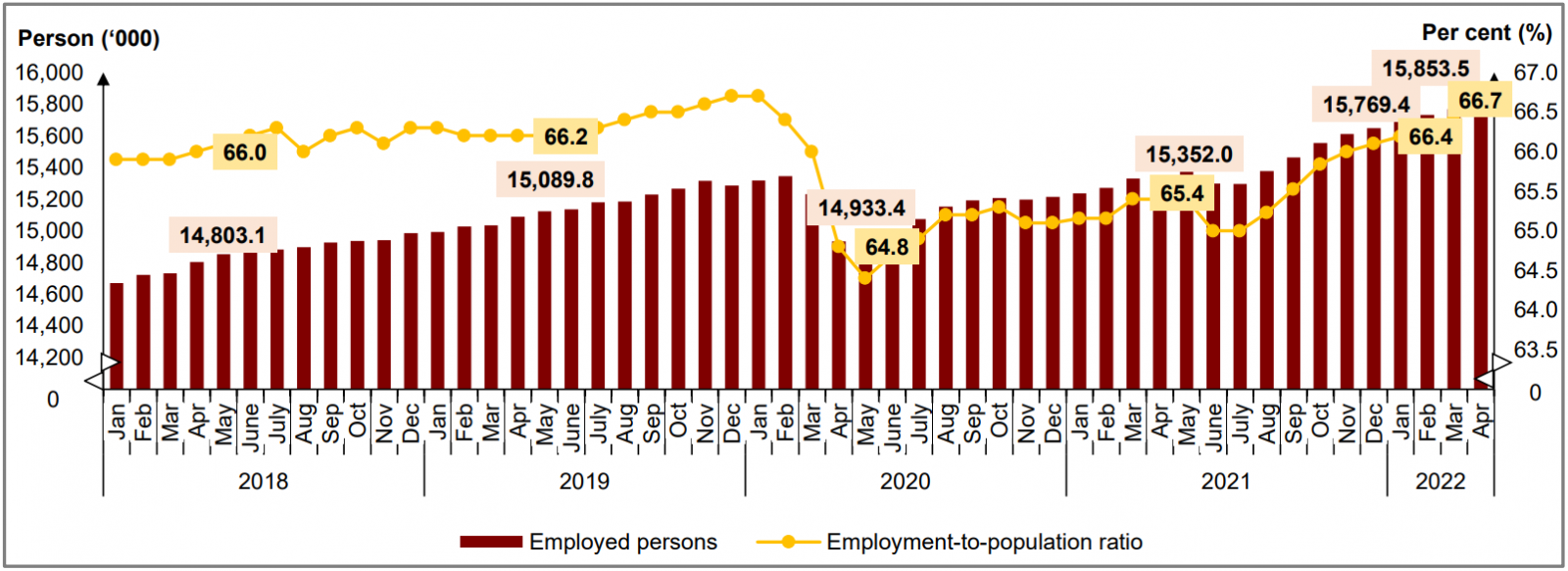
The employee’s category which made up the largest composition of employed persons at 76.3 per cent, improved by 0.3 per cent month-on-month to 12.09 million persons (March 2022: 12.06 million persons). Similarly, the own-account workers continued to increase with an addition of 31.9 thousand persons (+1.2%) to 2.72 million persons in April 2022 (March 2022: 2.69 million persons). The increase was partly due to more business activities in conjunction with the celebration of Ramadan and preparation for Aidilfitri during the month together with the reopening of international border which encouraged the tourism sector and tourism-related industries to resume their activities. This group comprises mostly of daily income earners working as small business operators such as retailers; hawkers; sellers in markets and stalls; as well as smallholders. [Chart 2
Chart 2: Employed person by status in employment, March and April 2022
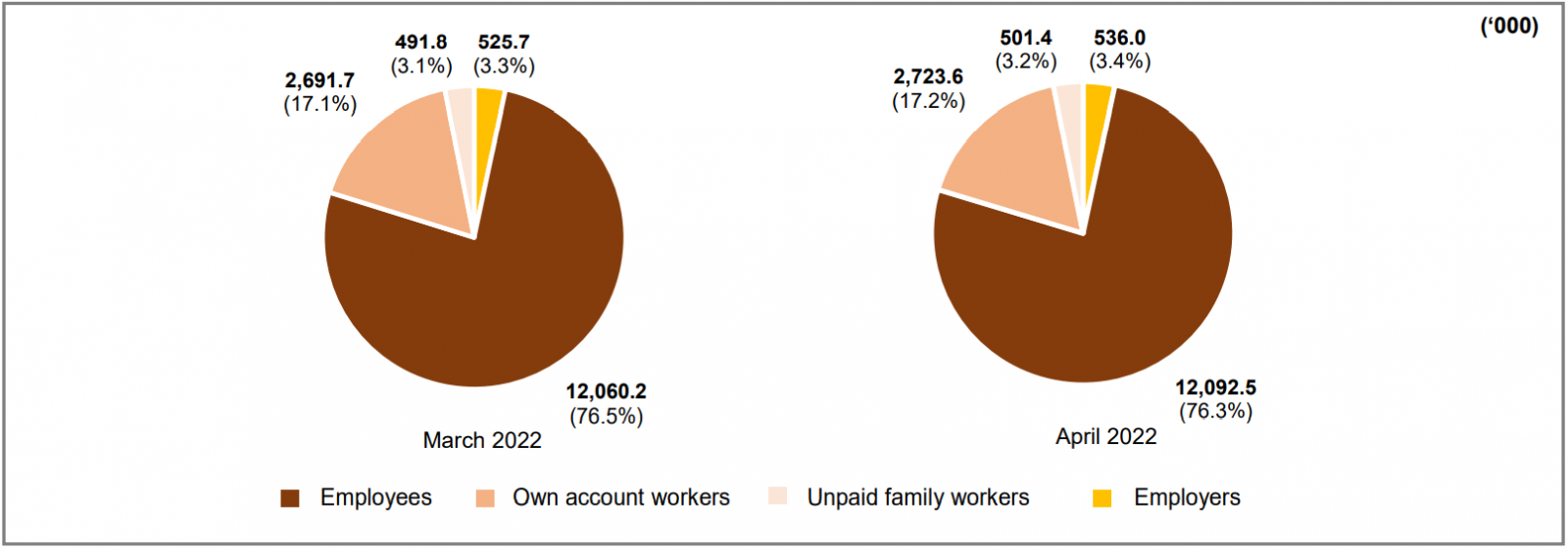
The number of employed persons who were temporarily not working recorded a decline of 6.0 per cent or 5.6 thousand persons to 88.3 thousand persons as against to the previous month (March 2022: 93.9 thousand persons). Similar trend was observed on the year-on-year basis, which recorded a fall of 27.7 thousand persons as compared to 116.0 thousand persons in April 2021. This group of persons, who were most likely not able to work were not categorised as unemployed as they had work to return to.
April’s unemployment rate declined to below 4.0 per cent for the first time to record 3.9 per cent
In April 2022, the number of unemployed persons continued to trend down for nine consecutive months, registering a fall of 3.0 per cent or equivalent to 19.9 thousand persons to 649.3 thousand unemployed persons (March 2022: 669.2 thousand persons). Meanwhile, on seasonally adjusted terms, the number of unemployed persons went down by 4.1 per cent. Hence, the unemployment rate declined to below 4.0 per cent for the first time to record 3.9 per cent (March 2022: 4.1%) after two years of the COVID-19 pandemic in the country. Seasonally adjusted estimates for April’s unemployment rate indicated a month-on-month decline by 0.2 percentage points to 3.9 per cent.
Year-on-year comparison, the number of unemployed persons reduced by 12.6 per cent or 93.4 thousand persons (April 2021: 742.7 thousand persons). The unemployment rate dropped by 0.7 percentage points as compared to April 2021 (4.6%). [Chart 3]
Chart 3: Unemployed persons and unemployment rate, 1982 - 2021 and January 2020 - April 2022

By unemployment category, most of the unemployed persons were the actively unemployed or those who were available for work and were actively seeking jobs. This category which comprised 83.6 per cent of the total unemployed persons, registered a decline of 3.2 per cent (-18.1 thousand persons) to 542.9 thousand persons (March 2022: 561.0 thousand persons). Out of the total actively unemployed, 58.1 per cent were those who were unemployed persons for less than three months, while 7.1 per cent were those who were in long-term unemployment of more than a year. Meanwhile, those who believed that there were no jobs available or the inactively unemployed continued to decrease by 1.6 per cent (-1.7 thousand persons) registering 106.4 thousand persons (March 2022: 108.1 thousand persons). [Chart 4]
Chart 4: Unemployed category and duration of unemployment, March and April 2022
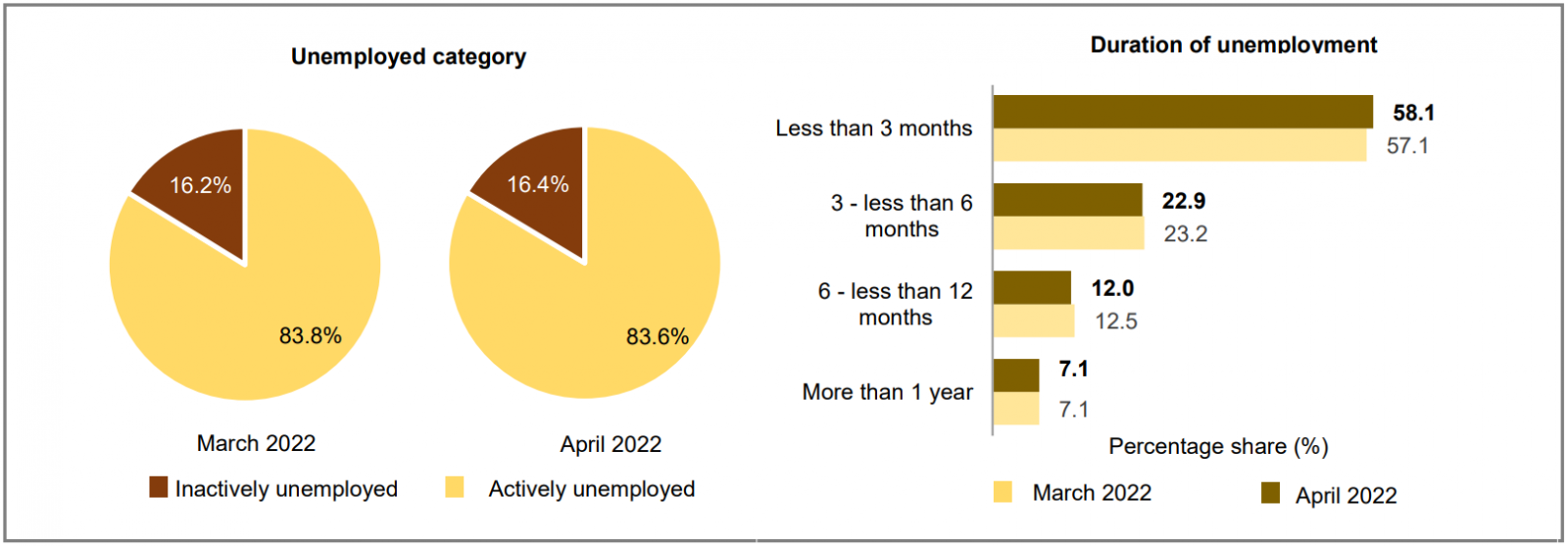
The unemployment rate for youth aged 15 to 24 years edged down by 0.3 percentage points to 12.8 per cent with the number of unemployed youths lessened by 3.8 thousand persons or 1.1 per cent to record 357.2 thousand persons (March 2022: 361.0 thousand persons). Likewise, the unemployment rate for youth aged 15 to 30 years decreased by 0.3 percentage points to 7.7 per cent, with the number of unemployed youths declining by 0.2 per cent (-1.2 thousand persons) of to 501.2 thousand persons (March 2022: 8.0%; 502.4 thousand persons). [Chart 5]
Chart 5: Unemployment rate by selected age groups, 1982 - 2021 and January 2020 - April 2022
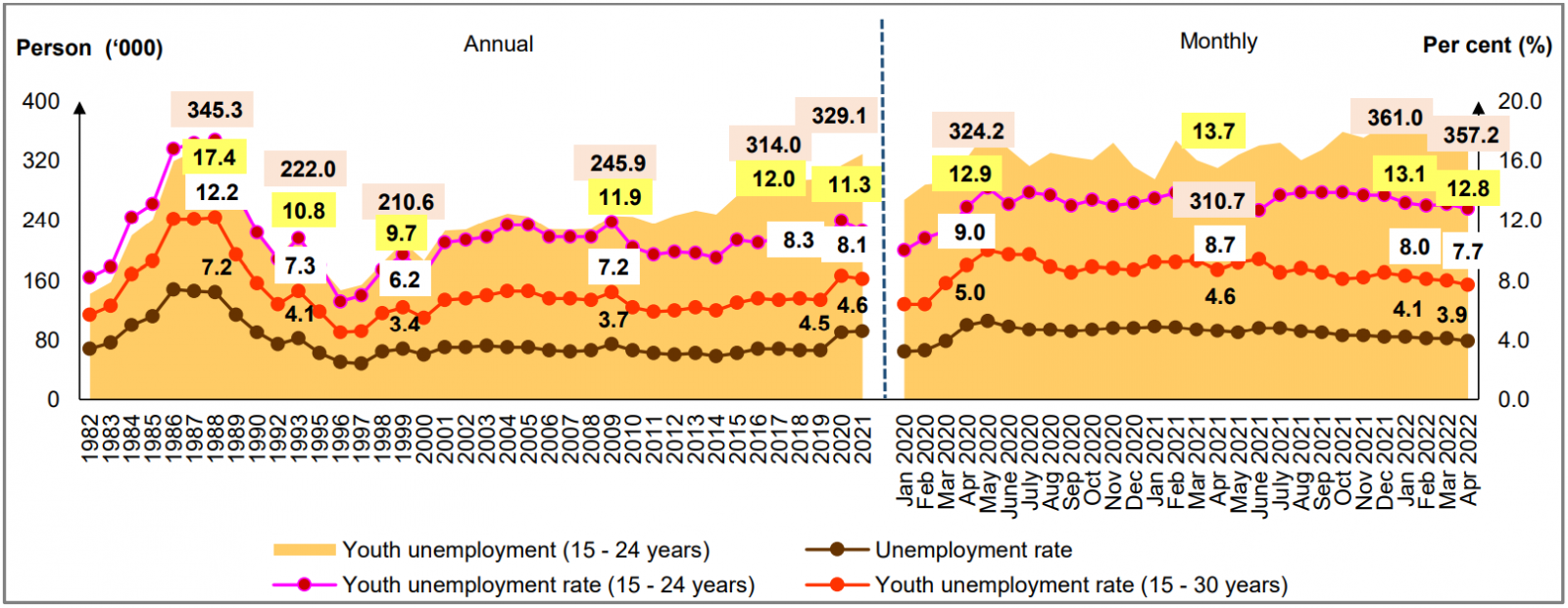
April’s LFPR rose by 0.2 percentage points to 69.4 per cent
In April 2022, the number of labour force recorded a surge of 0.4 per cent (+64.3 thousand persons) month-on-month to 16.50 million persons (March 2022: 16.44 million persons). Therefore, April’s labour force participation rate (LFPR) strengthened further by 0.2 percentage points to 69.4 per cent (March 2022: 69.2%), indicating more labour participation in the market. In terms of seasonally adjusted estimates, the number of labour force increased by 0.4 per cent while LFPR rose by 0.3 percentage points.
As compared to one year earlier, the number of labour force went up by 2.5 per cent or 408.1 thousand persons (April 2021: 16.09 million persons). The LFPR escalated by 0.8 percentage points as against 68.6 per cent in April 2021. [Chart 6]
Chart 6: Labour force and LFPR, 1982 - 2021 and January 2020 - April 2022

By gender comparison, male labour force registered an increase during the month to 10.15 million persons (March 2022: 10.08 million persons), while female labour force increased marginally to record 6.36 million persons. Therefore, both male and female LFPR edged up by 0.1 percentage points to 82.3 per cent and 55.5 per cent respectively. As compared to April 2021, male LFPR climbed by 1.3 percentage points (April 2021: 81.0%), whereas female LFPR rose by 0.3 percentage points (April 2021: 55.2%). [Chart 7]
Chart 7: Labour force and LFPR by sex, 1982 - 2021 and January 2020 - April 2022

The largest composition of outside labour force was housework/ family responsibilities
Following the shift into the phase of transition to endemic in April 2022, the number of persons outside labour force continued to decline with a reduction of 39.5 thousand persons (-0.5%) to record 7.27 million persons (March 2022: 7.31 million persons). Year-on-year, this number lessened by 106.6 thousand persons or 1.5 per cent (April 2021: 7.38 million persons). The largest composition of outside labour force was housework/ family responsibilities with 42.0 per cent and followed by schooling/ training category (40.6%). [Chart 8]
Chart 8: Share of outside labour force by reasons for not seeking work, March and April 2022
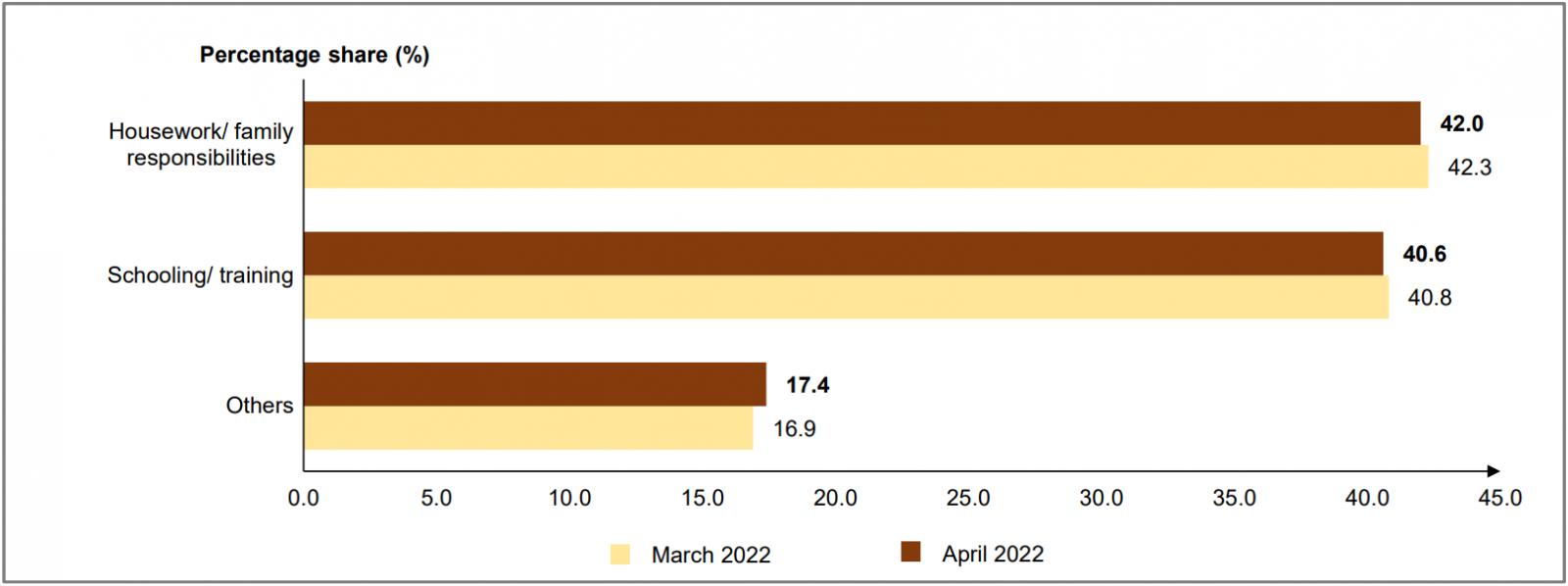
GOVERNMENT’S INITIATIVES
The Wage Subsidy Programme (PSU) is a financial aid paid to employers of each enterprise under the PRIHATIN Packages to assist employers to continue operate and retain employees. With a total approved value of RM12.96 billion as of 17 May 2022, PSU 1.0 has benefited 322,177 employers and 2.64 million registered employees. In addition, 81,155 employers received benefits of RM1.41 billion through PSU 2.0 under the Kita PRIHATIN Packages, allowing them to continue operating and retain 718,643 employees. Next, the PSU 3.0 was established to assist 162.3 thousand employers in retaining 1.53 million employees with a value of RM3.75 billion. Besides, RM2.53 billion was channelled to 161,572 employers and 1.9 million employees through PSU 4.0 under PEMULIH packages. Furthermore, through PSU 5.0, a total of RM165.4 billion was allocated to 7,077 employers in order to retain 100,663 employees.
In the meantime, as of 15 May 2022, a total of 15,176 employers and 116,404 employees had benefited from the Recruitment Incentive Programme (PenjanaKerjaya) with a total value of RM527.30 million under PenjanaKerjaya 1.0. There were 16,709 employers and 138,691 employees received an assistance of RM817.84 million under PenjanaKerjaya 2.0. Next, a total of RM512.39 million was channelled to 13,779 employers involving 84,608 employees under the PenjanaKerjaya 3.0 programme. Through the PenjanaKerjaya programme, the government provided RM1.85 billion to 45,664 employers, allowing them to retain 339,703 local employees. Moreover, the SOCSO's JaminKerja Keluarga Malaysia initiative had successfully placed 65,825 employees as of 30 April 2022. Additionally, the ATM Veteran Reskilling & Upskilling Programme (PRUV-ATM) which was specifically designed for retired army veteran, had provided skills and entrepreneurship training programmes to 8,736 veterans as of 30 April 2022.
Next, a total of 2,750 graduates were successfully placed through the Ministry of Higher Education's Career Advancement Program (KPT-CAP). In addition, a total of 2,479 fresh youths has been successfully placed using the JaminKerja Employment Incentive specifically for apprentices through the National Apprenticeship Scheme (SPN) under the Ministry of Youth and Sports in collaboration with other ministries such as the Ministry of Works and Ministry of Human Resources and Federal Agencies under all three ministries. As of 8 May, 2022, MyDigitalWorkforce Work in Tech (MYWiT) had successfully placed 649 participants from 3,596 applicants in technology and digital services jobs. In addition, the Professional Training and Education for Growing (PROTEGE) initiative through the Ministry of Entrepreneur Development and Cooperatives (MEDAC) for the implementation of the employability improvement programmes and foster entrepreneurial skills among graduates, there were 2,060 graduates were successfully placed as of 30 April 2022.
To empower businesses, MARA has approved a total of RM3.09 million for 350 new entrepreneurs as of 30 April 2022 under the Youth/ MARA Educational Institution Graduate Entrepreneur Programme (PUTRA), which was designed to provide financing facilities for micro businesses in all sectors, except agriculture and livestock farming, and to produce dynamic entrepreneurs among the younger generation who are eager to start a business. Additionally, a total of RM1.80 million has been channelled to 25 MARA technical entrepreneurs under the Technical Entrepreneur Development Programme (PUTEK), which was a financial facility for the younger generation to start a business in a technical field based on the abilities obtained under MARA. Next, as of 30 April 2022, a total of RM10 million was approved for Women's Special Business Financing Scheme (DanaNITA) to assist 265 women entrepreneurs who were affected by COVID-19 and to increase their business capacity. Besides, with an allocation of RM8.0 billion, the Targeted Relief and Residual Facility (TRRF) was issued as a lending facility to assist Small and Medium Enterprises (SMEs) that were affected in the services sector. A total of 20,800 SMEs was benefited from 34,330 applications, totalling RM5.62 billion as of 20 April 2022.
Moreover, 2,250 applications were approved from 2,978 total applications with an approved value of RM1.76 billion under the Agrofood Facilities (AF) provided by Bank Negara Malaysia (BNM), with the goal of driving the modernisation of the agricultural sector in order to increase food security and safety, generate higher income, and attract more younger agropreneurs. Besides, through the Professional Financing Scheme (ProSPEC) under MARA, which aims to provide business facilities and increase the participation of Bumiputera entrepreneurs in the field of professional entrepreneurship, a total of RM2.8 million was approved for nine professionals to venture into entrepreneurship as of 30 April 2022. In addition, a total of RM12.07 million was channelled to support 596 Micro SMEs under the Indian Community Entrepreneur Development Scheme (SPUMI), a strategic programme under TEKUN meant to assist the Indian community in developing their economy through business and entrepreneurship.
In the meantime, as of 13 May 2022, a total of 404 applications out of 765 total application were approved involving RM82.73 million funds through the PENJANA Tourism Financing programme, which was specifically allocated for Bumiputera SMEs to support SMEs and micro-SMEs which were still affected by the COVID-19 pandemic. Also, a total of RM92.9 million had been channelled to 13,893 businesses in the form of grants and loans for digitalisation services subscriptions to support and encourage SMEs and Technical and Digital Mid-tier Companies (MTCs) to digitalise their operations and trade channels. Later, the CENDANA programme, which was aimed to support the Arts, Culture, and Entertainment Sector, a total of RM7.24 million were allocated to 589 recipients, including artists and organisations who were actively involved in the Malaysian Arts and Culture industry.
LOOKING AHEAD
The current economic climate is heavily influenced by the global supply chain disruption following the ongoing geopolitical crisis, a weather condition as well as China’s strict COVID-19 containment action. In addition, certain countries had imposed ban on exports of selected goods in order to address shortages of products in the local market. On the contrary, improvement in demand following the ease of COVID-19 restrictions in most countries had also put pressure on the prices. In mitigating the higher inflation which is the main threat to the economic development, countries had started to adopt a stricter monetary policy by raising the interest rate to stem the increasing prices and demand. As for Malaysia, BNM has raised the interest rate by 25 basis points on 11 May 2022 due to rising prices and increased domestic demand and stable export performance. In this regards, Malaysia’s economic growth momentum could be hindered as inflation compromise demand while implementation of stringent monetary policy across countries may also affect products from Malaysia. This to some extent could also affect the positive trajectory of the national labour market.
However, a more positive economic outlook is observed as the country moved into the phase of transition to endemic. The increase in employers’ applications for non-citizen employment following the reopening of the country's international borders is anticipated to be able to ease the labour shortages issues especially in the Construction and Agriculture sectors; and subsequently further stimulate the country’s labour market situation. Furthermore, the inflow of international tourist could also contribute to the revival of the tourism industry particularly in the accommodation sub-sector. Besides the negativity of the depreciation of the MYR against the US Dollar towards the economy, it may also initiate positive impact on the tourism sector in terms of lower cost for tourists and it will make the country as a preferred holiday destination. Tourists spending also may facilitate small businesses to rebound after a two-year period of difficulties due to the pandemic. This situation is seen to open up more job opportunities since business activities require more workers to accommodate the growing demand for goods and services. Thus, the labour market is foreseen to be able to sustain its resiliency in the months to come. In line with the LI, which is an indicator for measuring the country's economic goals, shows that the short-term economy is expected to remain on the path of recovery.
TECHNICAL NOTES
This information is derived from the Labour Force Survey (LFS) which was conducted to collect information on the structure and distribution of labour force, employment and unemployment.
The survey population cover persons who live in private living quarters and excludes persons residing in institutions such as hotels, hostels, hospitals, prisons, boarding houses and workers residing in construction work site.
The survey comprises of the economically active and inactive population. To measure the economically active population, the LFS uses the age limit of 15 to 64 years. The economically active population comprises of those employed and unemployed whereas those who are inactive is classified as outside the labour force.
LFS uses the actual status approach, where a person is classified on the basis of his labour force activity during the reference week.
- Labour force refers to those who, during the reference week are in the 15 to 64 years (in completed years at last birthday) and who are either employed or unemployed.
- Employed refers to all persons who, at any time during the reference week worked at least one hour for pay, profit or family gain (as an employer, employee, own-account worker or unpaid family worker). Also considered as employed are persons who did not work during the reference week because of illness, injury, bad weather, leave, labour dispute and social or religious reasons but had a job, farm, enterprise or other family enterprise to return to. Also included are those on temporary lay-off with pay who would definitely be called back to work.
- Unemployed
Unemployed refers to those who do not have a job but are interested to work. There are two groups of unemployed that is the actively unemployed and inactively unemployed.
- Outside Labour Force
All persons not classified as employed or unemployed as stated above are classified as outside labour force. Includes housewives, students (including those going for further studies), retired, disabled persons and those not interested in looking for a job.
- Labour Force Participation Rate
The economic activity of a population depends on the demographic characteristics of that population. The proportion of economically active population, therefore, differs between sub-groups of that population. These variations are measured by specific activity rates termed as labour force participation rate. Labour force participation rate is defined as the ratio of the labour force to the working age population (15 to 64 years), expressed as percentage.
- Unemployment rate is the proportion of unemployed population to the total population in labour force. This rate measures the percentage of unemployed population in the labour force.
Population by characteristics of age group, ethnicity and state were used as benchmarks to produce labour statistics.
Starting with the monthly release of the Principal Statistics of Labour Force, Malaysia, January 2016, the principal statistics of labour is estimated based on the current population estimates as compared to the previous series which used population projections based on the Population and Housing Census of Malaysia, 2010. This rebase is to obtain statistics that is more consistent with current population structure.
The full publication of the Labour Force Report, April 2022 can be downloaded through eStatistik Portal.
For more details, please refer to the Department’s portal: www.dosm.gov.my
Released by:
DEPARTMENT OF STATISTICS, MALAYSIA
09 JUNE 2022
Contact person:
Mohd Yusrizal bin Ab. Razak
Public Relation Officer
Strategic Communication and International Division
Department of Statistics, Malaysia
Tel : +603-8885 7942
Fax : +603-8888 9248
Email : yusrizal.razak@dosm.gov.my
Subscribe
Newsletter
Subscribe to our newsletter and stay updated
For interviews, press statement and clarification to the media, contact:
Baharudin Mohamad
Public Relation Officer
Email: baharudin[at]dosm.gov.my
Phone: 03 8090 4681
Not found what you looking for? Request data from us, through
Go to eStatistik
Email: data[at]dosm.gov.my
Phone: 03 8885 7128 (data request)










